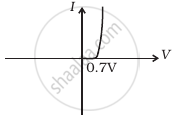Advertisements
Online Mock Tests
Chapters
2: Electrostatic Potential And Capacitance
3: Current Electricity
4: Moving Charges And Magnetism
5: Magnetism And Matter
6: Electromagnetic Induction
7: Alternating Current
8: Electromagnetic Waves
9: Ray Optics And Optical Instruments
10: Wave Optics
11: Dual Nature Of Radiation And Matter
12: Atoms
13: Nuclei
▶ 14: Semiconductor Electronics
15: Communication Systems
![NCERT Exemplar solutions for Physics [English] Class 12 chapter 14 - Semiconductor Electronics NCERT Exemplar solutions for Physics [English] Class 12 chapter 14 - Semiconductor Electronics - Shaalaa.com](/images/physics-english-class-12_6:5f2b1b2038084cf381bfa42c826a928c.jpg)
Advertisements
Solutions for Chapter 14: Semiconductor Electronics
Below listed, you can find solutions for Chapter 14 of CBSE NCERT Exemplar for Physics [English] Class 12.
NCERT Exemplar solutions for Physics [English] Class 12 14 Semiconductor Electronics Exercises [Pages 87 - 95]
MCQ I
The conductivity of a semiconductor increases with increase in temperature because ______.
number density of free current carriers increases.
relaxation time increases.
both number density of carriers and relaxation time increase.
number density of current carriers increases, relaxation time decreases but effect of decrease in relaxation time is much less than increase in number density.
In Figure, Vo is the potential barrier across a p-n junction, when no battery is connected across the junction ______.
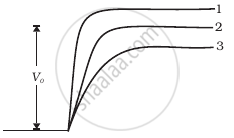
1 and 3 both correspond to forward bias of junction.
3 corresponds to forward bias of junction and 1 corresponds to reverse bias of junction.
1 corresponds to forward bias and 3 corresponds to reverse bias of junction.
3 and 1 both correspond to reverse bias of junction.
In Figure, assuming the diodes to be ideal ______.

D1 is forward biased and D2 is reverse biased and hence current flows from A to B.
D2 is forward biased and D1 is reverse biased and hence no current flows from B to A and vice versa.
D1 and D2 are both forward biased and hence current flows from A to B.
D1 and D2 are both reverse biased and hence no current flows from A to B and vice versa.
A 220 V A.C. supply is connected between points A and B (figure). What will be the potential difference V across the capacitor?

220 V
110 V
O V
`220 sqrt(2)` V
Hole is ______.
an anti-particle of electron.
a vacancy created when an electron leaves a covalent bond.
absence of free electrons.
an artifically created particle.
The output of the given circuit in figure is given below.
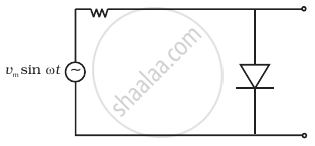
would be zero at all times.
would be like a half wave rectifier with positive cycles in output.
would be like a half wave rectifier with negative cycles in output.
would be like that of a full wave rectifier.
In the circuit shown in figure, if the diode forward voltage drop is 0.3 V, the voltage difference between A and B is ______.

1.3 V
2.3 V
0
0.5 V
Truth table for the given circuit (Figure) is ______.
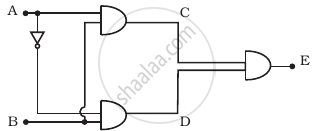
A B E 0 0 1 0 1 0 1 0 1 1 1 0 A B E 0 0 1 0 1 0 1 0 0 1 1 1 A B E 0 0 1 0 1 1 1 0 0 1 1 1 A B E 0 0 0 0 1 1 1 0 1 1 1 0
MCQ II
When an electric field is applied across a semiconductor ______.
- electrons move from lower energy level to higher energy level in the conduction band.
- electrons move from higher energy level to lower energy level in the conduction band.
- holes in the valence band move from higher energy level to lower energy level.
- holes in the valence band move from lower energy level to higher energy level.
a and b
b and c
d and a
a and c
Consider an npn transistor with its base-emitter junction forward biased and collector base junction reverse biased. Which of the following statements are true?
- Electrons crossover from emitter to collector.
- Holes move from base to collector.
- Electrons move from emitter to base.
- Electrons from emitter move out of base without going to the collector.
d and a
a and b
b and c
a and c
Figure shows the transfer characteristics of a base biased CE transistor. Which of the following statements are true?

At Vi = 0.4 V, transistor is in active state.
At Vi = 1 V, it can be used as an amplifier.
At Vi = 0.5 V, it can be used as a switch turned off.
At Vi = 2.5 V, it can be used as a switch turned on.
a and c
a, c and d
b and c
b, c and d
In a npn transistor circuit, the collector current is 10 mA. If 95 per cent of the electrons emitted reach the collector, which of the following statements are true?
- The emitter current will be 8 mA.
- The emitter current will be 10.53 mA.
- The base current will be 0.53 mA.
- The base current will be 2 mA.
a and c
a, c and d
b and c
b, c and d
In the depletion region of a diode ______.
- there are no mobile charges.
- equal number of holes and electrons exist, making the region neutral.
- recombination of holes and electrons has taken place.
- immobile charged ions exist.
a and b
a, b and d
c and d
a, b, c and d
What happens during regulation action of a Zener diode?
- The current in and voltage across the Zenor remains fixed.
- The current through the series Resistance (Rs) changes.
- The Zener resistance is constant.
- The resistance offered by the Zener changes.
a and b
b and d
b and c
c and d
To reduce the ripples in a rectifier circuit with capacitor filter ______.
- RL should be increased.
- input frequency should be decreased.
- input frequency should be increased.
- capacitors with high capacitance should be used.
a and c
b and d
a, c and d
b, c and d
The breakdown in a reverse biased p–n junction diode is more likely to occur due to ______.
- large velocity of the minority charge carriers if the doping concentration is small.
- large velocity of the minority charge carriers if the doping concentration is large.
- strong electric field in a depletion region if the doping concentration is small.
- strong electric field in the depletion region if the doping concentration is large.
a and d
b and d
c and d
b and c
VSA
Why are elemental dopants for Silicon or Germanium usually chosen from group XIII or group XV?
Sn, C, and Si, Ge are all group XIV elements. Yet, Sn is a conductor, C is an insulator while Si and Ge are semiconductors. Why?
Can the potential barrier across a p-n junction be measured by simply connecting a voltmeter across the junction?
Draw the output waveform across the resistor (Figure).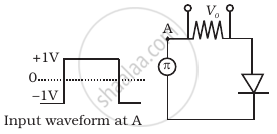
The amplifiers X, Y and Z are connected in series. If the voltage gains of X, Y and Z are 10, 20 and 30, respectively and the input signal is 1 mV peak value, then what is the output signal voltage (peak value)
- if dc supply voltage is 10V?
- if dc supply voltage is 5V?
In a CE transistor amplifier there is a current and voltage gain associated with the circuit. In other words there is a power gain. Considering power a measure of energy, does the circuit voilate conservation of energy?
SA
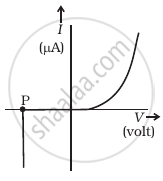 (a) |
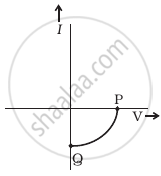 (b) |
- Name the type of a diode whose characteristics are shown in figure (A) and figure (B).
- What does the point P in figure (A) represent?
- What does the points P and Q in figure (B) represent?
Three photo diodes D1, D2 and D3 are made of semiconductors having band gaps of 2.5 eV, 2 eV and 3 eV, respectively. Which 0 ones will be able to detect light of wavelength 6000 Å?
If the resistance R1 is increased (Figure), how will the readings of the ammeter and voltmeter change?
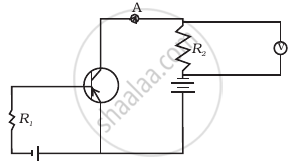
Two car garages have a common gate which needs to open automatically when a car enters either of the garages or cars enter both. Devise a circuit that resembles this situation using diodes for this situation.
How would you set up a circuit to obtain NOT gate using a transistor?
Explain why elemental semiconductor cannot be used to make visible LEDs.
Write the truth table for the circuit shown in figure. Name the gate that the circuit resembles.
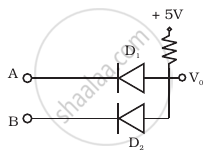
A Zener of power rating 1 W is to be used as a voltage regulator. If zener has a breakdown of 5 V and it has to regulate voltage which fluctuated between 3 V and 7 V, what should be the value of Rs for safe operation (Figure)?

LA
If each diode in figure has a forward bias resistance of 25 Ω and infinite resistance in reverse bias, what will be the values of the current I1, I2, I3 and I4?
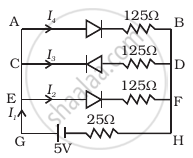
In the circuit shown in figure, when the input voltage of the base resistance is 10 V, Vbe is zero and Vce is also zero. Find the values of Ib, Ic and β.
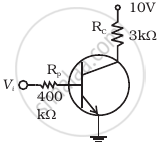
Draw the output signals C1 and C2 in the given combination of gates (Figure).

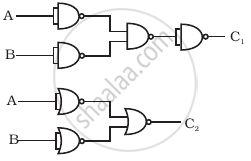
Consider the circuit arrangement shown in figure (a) for studying input and output characteristics of npn transistor in CE configuration.
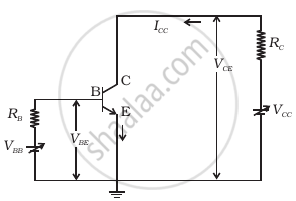 (a) |
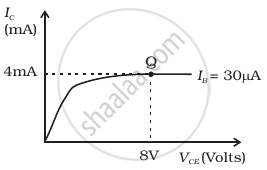 (b) |
Select the values of RB and RC for a transistor whose VBE = 0.7 V, so that the transistor is operating at point Q as shown in the characteristics shown in figure (b). Given that the input impedance of the transistor is very small and VCC = VBB = 16 V, also find the voltage gain and power gain of the circuit making appropriate assumptions.
Assuming the ideal diode, draw the output waveform for the circuit given in figure. Explain the waveform.

Suppose a ‘n’-type wafer is created by doping Si crystal having 5 × 1028 atoms/m3 with 1 ppm concentration of As. On the surface 200 ppm Boron is added to create ‘P’ region in this wafer. Considering n i = 1.5 × 1016 m–3, (i) Calculate the densities of the charge carriers in the n and p regions. (ii) Comment which charge carriers would contribute largely for the reverse saturation current when diode is reverse biased.
An X-OR gate has following truth table:
| A | B | Y |
| 0 | 0 | 0 |
| 0 | 1 | 1 |
| 1 | 0 | 1 |
| 1 | 1 | 0 |
It is represented by following logic relation `Y = barA.B + A.barB`. Build this gate using AND, OR and NOT gates.
Consider a box with three terminals on top of it as shown in figure (a):
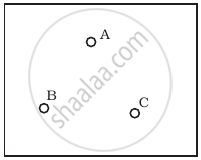 (a) |
Three components namely, two germanium diodes and one resistor are connected across these three terminals in some arrangement. A student performs an experiment in which any two of these three terminals are connected in the circuit shown in figure (b).
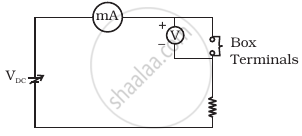 (b) |
The student obtains graphs of current-voltage characteristics for unknown combination of components between the two terminals connected in the circuit. The graphs are
(i) when A is positive and B is negative
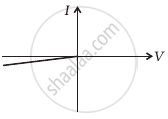 (c) |
(ii) when A is negative and B is positive
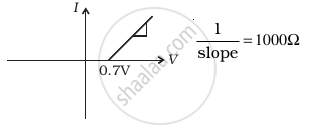 (d) |
(iii) When B is negative and C is positive
|
(e) |
(iv) When B is positive and C is negative
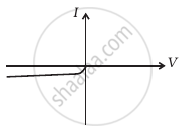 (f) |
(v) When A is positive and C is negative
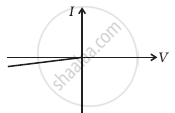 (g) |
(vi) When A is negative and C is positive
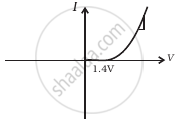 (h) |
From these graphs of current-voltage characteristics shown in figure (c) to (h), determine the arrangement of components between A, B and C.
For the transistor circuit shown in figure, evaluate VE, RB, RE given IC = 1 mA, VCE = 3 V, VBE = 0.5 V and VCC = 12 V, β = 100.
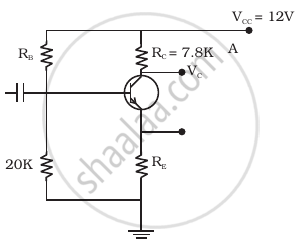
In the circuit shown in figure, find the value of RC.
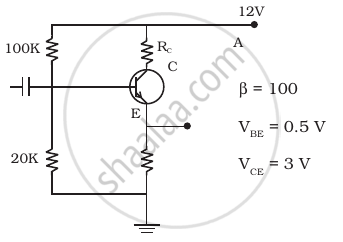
Solutions for 14: Semiconductor Electronics
![NCERT Exemplar solutions for Physics [English] Class 12 chapter 14 - Semiconductor Electronics NCERT Exemplar solutions for Physics [English] Class 12 chapter 14 - Semiconductor Electronics - Shaalaa.com](/images/physics-english-class-12_6:5f2b1b2038084cf381bfa42c826a928c.jpg)
NCERT Exemplar solutions for Physics [English] Class 12 chapter 14 - Semiconductor Electronics
Shaalaa.com has the CBSE Mathematics Physics [English] Class 12 CBSE solutions in a manner that help students grasp basic concepts better and faster. The detailed, step-by-step solutions will help you understand the concepts better and clarify any confusion. NCERT Exemplar solutions for Mathematics Physics [English] Class 12 CBSE 14 (Semiconductor Electronics) include all questions with answers and detailed explanations. This will clear students' doubts about questions and improve their application skills while preparing for board exams.
Further, we at Shaalaa.com provide such solutions so students can prepare for written exams. NCERT Exemplar textbook solutions can be a core help for self-study and provide excellent self-help guidance for students.
Concepts covered in Physics [English] Class 12 chapter 14 Semiconductor Electronics are Concept of Semiconductor Electronics: Materials, Devices and Simple Circuits, Integrated Circuits, Feedback Amplifier and Transistor Oscillator, Transistor as a Device, Basic Transistor Circuit Configurations and Transistor Characteristics, Application of Junction Diode as a Rectifier, p-n Junction, Intrinsic Semiconductor, Classification of Metals, Conductors and Semiconductors, Extrinsic Semiconductor, Transistor Action, Transistor: Structure and Action, Semiconductor Diode, Energy Bands in Conductors, Semiconductors and Insulators, Triode, Digital Electronics and Logic Gates, Transistor as an Amplifier (Ce-configuration), Transistor and Characteristics of a Transistor, Zener Diode as a Voltage Regulator, Special Purpose P-n Junction Diodes, Diode as a Rectifier.
Using NCERT Exemplar Physics [English] Class 12 solutions Semiconductor Electronics exercise by students is an easy way to prepare for the exams, as they involve solutions arranged chapter-wise and also page-wise. The questions involved in NCERT Exemplar Solutions are essential questions that can be asked in the final exam. Maximum CBSE Physics [English] Class 12 students prefer NCERT Exemplar Textbook Solutions to score more in exams.
Get the free view of Chapter 14, Semiconductor Electronics Physics [English] Class 12 additional questions for Mathematics Physics [English] Class 12 CBSE, and you can use Shaalaa.com to keep it handy for your exam preparation.
